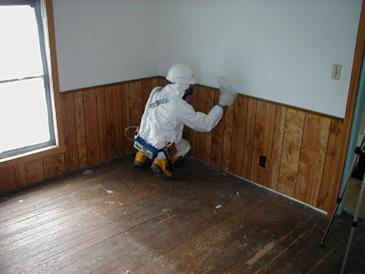
© ATSDRAn inspector screens a home in Libby for asbestos.
Northwest Montana, best known for its mountains, bighorn sheep, moose, and bear has also become known as a deadly place to live.
Health officials say as many as 200 people have died and another 1,000 residents - nearly 50 percent of the population of this small city -- have been sickened by asbestos-related illnesses.
Last month the U.S. Environmental Protection Agency (EPA) declared a public health emergency in Libby and the surrounding area as a result of contamination created by asbestos mining in the region during the last century, and announced it will spend about $130 million to clean up the contamination and provide medical care in the region.
Residents of this northwest Montana city of about 2,600 south of the Canadian border, who have been dealing with the threat of asbestos-related illnesses and deaths for years, welcomed the news.
Eric Christiansen has been the pastor of St. John Lutheran Church for 13 years.
Of the 75 funerals he's conducted during his years in the community, Christiansen said about a dozen were attributed to asbestos. Christiansen said asbestos was so common here that it was once mixed in the soil of ball fields and in school running tracks.
Those public facilities have since been cleaned up as well as a school that was once owned by his church. The church has since sold the school. The EPA, said Christiansen, has been working hard in the community recently.
"The EPA is trying very hard to do the right thing," he said.
"The $125 million that EPA will spend from 2009 through 2013 will enable the Agency to remove vermiculite insulation from accessible attics/crawl spaces; clean contaminated indoor living spaces; and remove contaminated soil at hundreds of properties," said a statement issued by the EPA. "These cleanup activities should significantly reduce the risk of asbestos-related diseases in the residents."
The EPA, through its Superfund program, has been working in the community for nearly 10 years and in the past has cleaned up the site of the mine and related buildings. As many as 1,400 homes and businesses still need to be cleaned up.
Town officials hope last month's news will provide new life for their community. "Folks are afraid to move here," said Doug Roll, Libby's mayor.
Roll was speaking from his auto repair shop in Libby, one of the many service businesses here that serves residents in an economy that was once dominated by mining and logging.
But now it is the federal government that provides many jobs in the area and owns 75-80 percent of nearby forestlands.
In 1881, gold miners in Libby discovered vermiculite, a mineral that has been used in building insulation and as a soil conditioner. By the 1920s the Zonolite Company formed and began mining the vermiculite. And in 1963, W.R. Grace bought the Zonolite mining operations. The mine closed in 1990.
While in operation, the Libby mine may have produced 80 percent of the world's supply of vermiculite. Unfortunately, the vermiculite from the Libby mine was contaminated with a toxic form of naturally occurring asbestos called tremolite-actinolite asbestiform mineral fibers.
Tremolite asbestos has been linked to mesothelioma, a cancer which affects the linings of the lings, heart and abdomen, contaminated the vermiculite.
And until the mine closed, dust generated from the mine covered the mineworkers and was brought home to their families.
"It's a big concern," said Roll, of asbestos contamination.
Roll said many local residents have fallen ill or know someone who has, from the contamination. In May, a jury acquitted executives of W.R. Grace, which operated the mine from 1963-1990, of knowingly contaminating the community and hiding the affects from the public.
The company spent millions to help pay medical bills and last year agreed to pay $250 million to the EPA for the cleanup. But from 2000-2008, Roll said federal government paid little attention to the asbestos problem here.
The Center for Asbestos Related Disease, a local health organization that conducts research and provides screenings for asbestos-related illnesses, applauded the action by the EPA.
"Without their unwavering support, the community would still be challenged in its efforts to provide heath care for those whose health has been or will be adversely affected," said a statement released by the CARD clinic.
The EPA says that while there's no toxic cloud hanging the region, residents are still vulnerable if they're exposed to vermiculite in attics and crawl spaces or disturb contaminated soil.
As the EPA begins to implement this round of care for local residents, the residents themselves have learned to live with the danger for generations.
"These are extremely independent people, extremely proud people," said Christiansen. "People weren't afraid of it. Their attitude is that to move on."
But even while the community is being cleaned of a contaminant it did not invite, the Rev. Richard Hunting, a chaplain who has provided spiritual care for mining families, said he's perplexed why smoking is so prevalent in a community where damaged lungs are quite common.
"They have so much proof here," he added.
EPA's action last month is the first time the agency has announced a determination under the Comprehensive Environmental Response, Compensation, and Liability Act (CERCLA) that conditions at a site constitute a public health emergency.
In her announcement, Lisa P. Jackson, the agency's administrator, said the EPA is working closely with the Department of Health and Human Services, which is making available a short-term grant to provide needed asbestos-related medical care to area residents.
"This is a long-overdue, common-sense decision that will go a long way for Libby and the thousands of folks who were poisoned there," Sen. Jon Tester said. "This decision will help make quality health care more accessible and it will open the door to get new resources on the ground. We still have a long way to do right by the folks in Libby."
Reader Comments
to our Newsletter